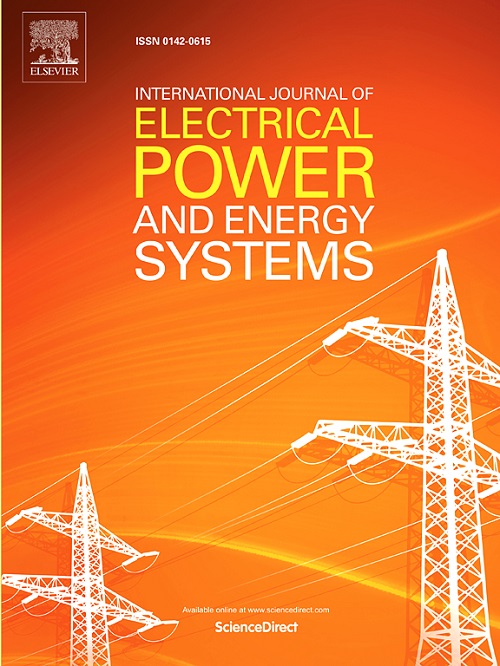An integrated energy management strategy for plug-in hybrid electric buses based on receding horizon control and TD3 algorithm
IF 5
2区 工程技术
Q1 ENGINEERING, ELECTRICAL & ELECTRONIC
International Journal of Electrical Power & Energy Systems
Pub Date : 2025-09-27
DOI:10.1016/j.ijepes.2025.111103
引用次数: 0
Abstract
Due to its exceptional performance in terms of fuel efficiency, emissions reduction and driving convenience, the plug-in hybrid electric vehicle (PHEV) possesses a broad application market and development potential. However, the utilization of multiple power sources necessitates a rational and efficient energy management strategy (EMS) to coordinate multiple power sources to achieve efficient power output. In this study, an EMS within the receding horizon control (RHC) framework is proposed for the plug-in hybrid electric bus (PHEB), and a strategy based on twin delayed deep deterministic policy gradient (TD3) algorithm is introduced as a complementary strategy to enhance the robustness of the EMS. First, a vehicle velocity prediction model is constructed based on the gated recurrent unit (GRU) neural network with an attention mechanism to enable accurate prediction of future velocity in a finite horizon. Subsequently, a multi-objective RHC framework is established to effectively coordinate the objectives of vehicle fuel economy improvement and battery degradation mitigation. The power allocation problem is formulated as a rolling optimization issues over a finite prediction horizon, and the optimal control sequence is solved by the alternating direction method of multipliers (ADMM) algorithm. Additionally, the real-time monitoring of velocity prediction error enables the control system to timely switch to the TD3-based EMS when the error exceeds the preset range, so as to cope with unexpected situations. The simulation results demonstrate that the proposed EMS ensures reasonable battery charging and discharging under different initial state of charge (SOC) and driving distances, and mitigates battery degradation. Meanwhile, in comparison to the separate RHC strategy and TD3-based strategy, the proposed integrated EMS reduces the total cost of PHEB by 5.50% and 7.03%, respectively, thereby highlighting the superior fuel efficiency and adaptability to different driving conditions of the EMS.
基于后退地平线控制和TD3算法的插电式混合动力客车综合能量管理策略
插电式混合动力汽车(PHEV)由于其在燃油效率、减排和驾驶便利性方面的优异性能,具有广阔的应用市场和发展潜力。然而,多电源的利用需要合理高效的能源管理策略(EMS)来协调多个电源,以实现高效的功率输出。本文针对插电式混合动力客车(PHEB)提出了一种后退地平线控制(RHC)框架下的EMS,并引入了一种基于双延迟深度确定性策略梯度(TD3)算法的策略作为补充策略,增强了EMS的鲁棒性。首先,基于门控循环单元(GRU)神经网络构建了车辆速度预测模型,并引入了注意机制,实现了在有限视界内对未来速度的准确预测;随后,建立了多目标RHC框架,以有效协调汽车燃油经济性提高和电池退化缓解的目标。将功率分配问题表述为有限预测范围内的滚动优化问题,采用交替方向乘法器(ADMM)算法求解最优控制序列。同时,通过对速度预测误差的实时监测,使控制系统在速度预测误差超过预设范围时,能够及时切换到基于td3的EMS,以应对突发情况。仿真结果表明,该方法在不同初始充电状态(SOC)和行驶距离下保证了电池合理充放电,减轻了电池劣化。同时,与单独的RHC策略和基于td3的策略相比,所提出的集成EMS将PHEB的总成本分别降低了5.50%和7.03%,从而突出了EMS优越的燃油效率和对不同驾驶条件的适应性。
本文章由计算机程序翻译,如有差异,请以英文原文为准。
求助全文
约1分钟内获得全文
求助全文
来源期刊
CiteScore
12.10
自引率
17.30%
发文量
1022
审稿时长
51 days
期刊介绍:
The journal covers theoretical developments in electrical power and energy systems and their applications. The coverage embraces: generation and network planning; reliability; long and short term operation; expert systems; neural networks; object oriented systems; system control centres; database and information systems; stock and parameter estimation; system security and adequacy; network theory, modelling and computation; small and large system dynamics; dynamic model identification; on-line control including load and switching control; protection; distribution systems; energy economics; impact of non-conventional systems; and man-machine interfaces.
As well as original research papers, the journal publishes short contributions, book reviews and conference reports. All papers are peer-reviewed by at least two referees.

 求助内容:
求助内容: 应助结果提醒方式:
应助结果提醒方式:


